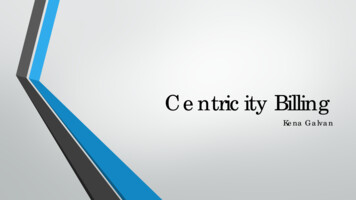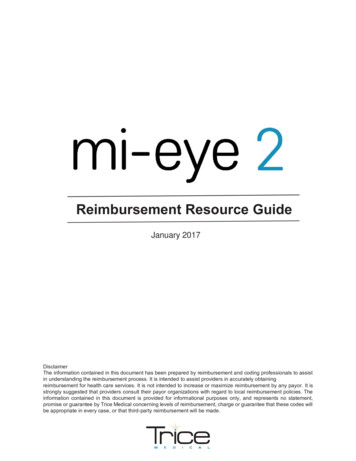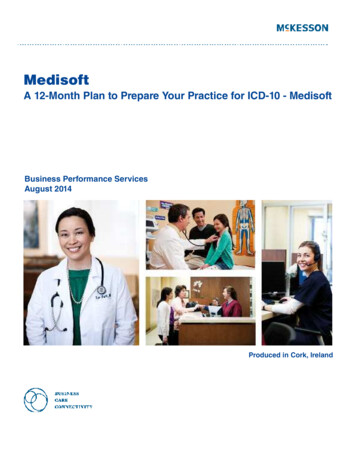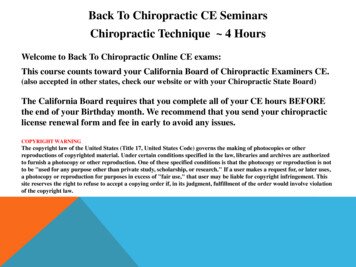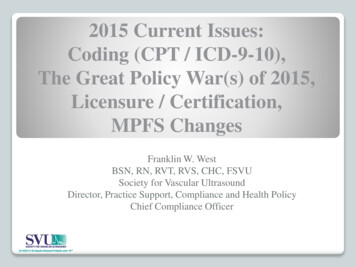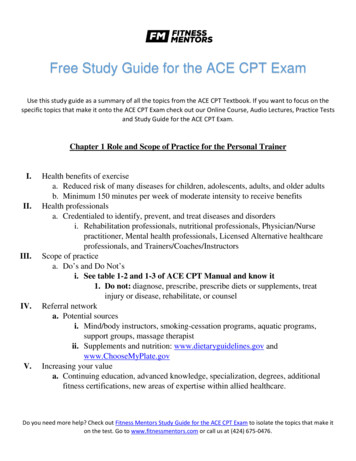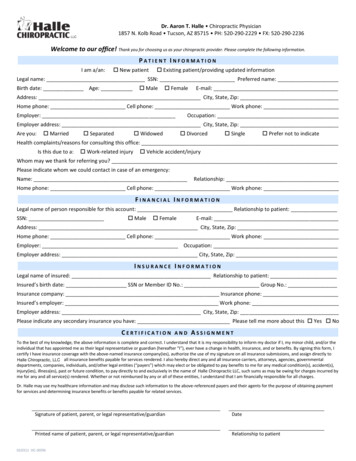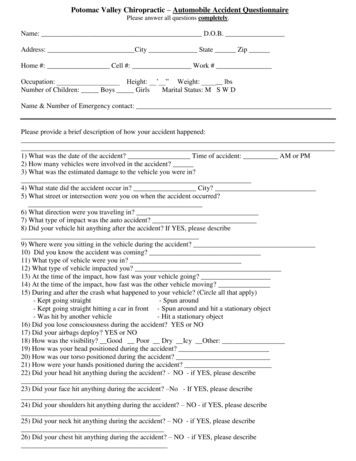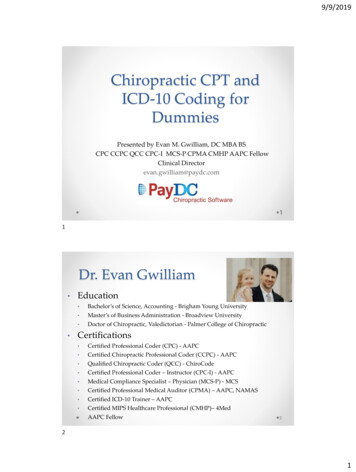
Transcription
9/9/2019Chiropractic CPT andICD-10 Coding forDummiesPresented by Evan M. Gwilliam, DC MBA BSCPC CCPC QCC CPC-I MCS-P CPMA CMHP AAPC FellowClinical Directorevan.gwilliam@paydc.com11Dr. Evan Gwilliam Education Bachelor’s of Science, Accounting - Brigham Young University Master’s of Business Administration - Broadview University Doctor of Chiropractic, Valedictorian - Palmer College of ChiropracticCertifications Certified Professional Coder (CPC) - AAPC Certified Chiropractic Professional Coder (CCPC) - AAPC Qualified Chiropractic Coder (QCC) - ChiroCode Certified Professional Coder – Instructor (CPC-I) - AAPC Medical Compliance Specialist – Physician (MCS-P) - MCS Certified Professional Medical Auditor (CPMA) – AAPC, NAMAS Certified ICD-10 Trainer – AAPC Certified MIPS Healthcare Professional (CMHP)– 4Med AAPC Fellow221
9/9/2019Audit Your Own Evaluationand Management EncounterPresented by Evan M. Gwilliam, DC MBA BSCPC CCPC QCC CPC-I MCS-P CPMA CMHP AAPC FellowClinical Director3Take Away Get familiar with the basics of E/M Understand how auditors andcoders look at E/M codes442
9/9/2019Evaluation & Management 1992 Evaluation and Management (E/M) codesintroduced by the Centers for Medicare andMedicaid Services (CMS) and the AmericanMedical Association (AMA).1995 Documentation Guidelines (DGs) Exam scored by number of different systemsWorks better for general practitioners1997 Documentation Guidelines (DGs) Single organ system exam bullet listsWorks better for specialists5Evaluation & ManagementOffice/OutpatientNew PatientOffice/OutpatientEstablished 1499215*A new patient is one who has not received any professionalservices from the physician .within the past three years.63
9/9/2019Evaluation & ManagementThree Key Components: HistoryPhysical ExaminationMedical Decision MakingContributing Factors: Nature of Presenting ProblemTimeCounselingCoordination of Care7Nature of thePresenting ProblemMedical necessity is the overarching criterion forpayment.“The correct code for an E&M visit should be chosenbased on the complexity of the visit. This isdetermined by the number of problems and the extentthat the problems are addressed and documented inthe record. The amount of documentation should notbe the primary factor for what level of service isbilled.”-BCBS84
9/9/2019Nature of thePresenting ProblemA presenting problem is a disease, condition, illness, injury,symptom, sign, finding, complaint, or other reason forencounter, with or without a diagnosis being established at thetime of the encounter. The E/M codes recognize five types ofpresenting problems that are defined as follows:Minimal: A problem that may not require the presence of thephysician or other qualified health care professional, but serviceis provided under the physician’s or other qualified health careprofessional’s supervision.Self-limited or minor: A problem that runs a definite andprescribed course, is transient in nature, and is not likely topermanently alter health status OR has a good prognosis withmanagement/compliance.9Nature of thePresenting ProblemLow severity: A problem where the risk of morbidity withouttreatment is low; there is little to no risk of mortality withouttreatment; full recovery without functional impairment isexpected.Moderate severity: A problem where the risk of morbiditywithout treatment is moderate; there is moderate risk of mortalitywithout treatment; uncertain prognosis OR increased probabilityof prolonged functional impairment.High severity: A problem where the risk of morbidity withouttreatment is high to extreme; there is a moderate to high risk ofmortality without treatment OR high probability of severe,prolonged functional impairment.105
9/9/2019Nature of thePresenting ProblemNew Patient E/M99201Self-limited or minor99202Low to Moderate severity99203Moderate severity99204Moderate to High severity99205Moderate to High severity11Three Key ComponentsNew Patient E/M (3 of 3)HistoryExamMDMSupplied by thepatientSupplied bythe providerBrain power126
9/9/2019Three Key ComponentsNew Patient E/M (3 of 3)HistoryExamMDM99201Problem FocusedProblem FocusedStraightforward99202ExpandedProblem FocusedExpandedProblem FocusedStraightforward99203DetailedDetailedLow Complexity99204ComprehensiveComprehensiveModerate Complexity99205ComprehensiveComprehensiveHigh Complexity13New Patient E/M Matrix (3 of 3)History (3 of 3)ExamMDM (2 of 3)CCHPIROSPFSH’95 DGs’97 /a2-76-1110-1min99203Y4 2-91-22x-7x12 in 222low99204Y4 10 38 18 in 933mod99205Y4 10 38 18 in 944high147
9/9/2019Evaluation &Management:History15New Patient E/M Matrix (3 of 3)History (3 of 3)ExamMDM (2 of 3)CCHPIROSPFSH’95 DGs’97 /a2-76-1110-1min99203Y4 2-91-22x-7x12 in 222low99204Y4 10 38 18 in 933mod99205Y4 10 38 18 in 944high168
9/9/201917New Patient E/M Matrix (3 of 3)History (3 of 3)ExamMDM (2 of 3)CCHPIROSPFSH’95 DGs’97 /a2-76-1110-1min99203Y4 2-91-22x-7x12 in 222low99204Y4 10 38 18 in 933mod99205Y4 10 38 18 in 944high189
9/9/2019“HPI is a chronological description of the development of the patient’spresent illness from the first sign and/or symptom or from the previousencounter to the present.” ‘97 DGs19Clinical ExampleChief Complaint: Neck pain with right armtingling.History of present illness:Location: central C4-C6 radiating to rightposterior arm and elbowQuality: tingling and shooting painSeverity: 6-8/10 on the VASTiming: constantDuration: two daysContext: MVA, driver of vehicle struck frombehind when at stop lightModifying: Feels better with restAssociated signs and symptoms: n/aReview of systems:Cardiovascular: no past issuesNeurological: no past issuesEndocrine: Type II diabeticMusculoskeletal: Knee replaced, 2007Past history: He takes oral medication for hisdiabetes, and was hospitalized for kneereplacement in 2007. He was treated at thisclinic for LBP in 2014.Family history: Father and one sibling havetype II diabetes.2010
9/9/2019New Patient E/M Matrix (3 of 3)History (3 of 3)ExamMDM (2 of 3)CCHPIROSPFSH’95 DGs’97 /a2-76-1110-1min99203Y4 2-91-22x-7x12 in 222low99204Y4 10 38 18 in 933mod99205Y4 10 38 18 in 944high212211
9/9/2019Clinical ExampleChief Complaint: Neck pain with right armtingling.History of present illness:Location: central C4-C6 radiating to rightposterior arm and elbowQuality: tingling and shooting painSeverity: 6-8/10 on the VASTiming: constantDuration: two daysContext: MVA, driver of vehicle struck frombehind when at stop lightModifying: Feels better with restAssociated signs and symptoms: n/aReview of systems:Cardiovascular: no past issuesNeurological: no past issuesEndocrine: Type II diabeticMusculoskeletal: Knee replaced, 2007Past history: He takes oral medication for hisdiabetes, and was hospitalized for kneereplacement in 2007. He was treated at thisclinic for LBP in 2014.Family history: Father and one sibling havetype II diabetes.23New Patient E/M Matrix (3 of 3)History (3 of 3)ExamMDM (2 of 3)CCHPIROSPFSH’95 DGs’97 /a2-76-1110-1min99203Y4 2-91-22x-7x12 in 222low99204Y4 10 38 18 in 933mod99205Y4 10 38 18 in 944high2412
9/9/201925Clinical ExampleChief Complaint: Neck pain with right armtingling.History of present illness:Location: central C4-C6 radiating to rightposterior arm and elbowQuality: tingling and shooting painSeverity: 6-8/10 on the VASTiming: constantDuration: two daysContext: MVA, driver of vehicle struck frombehind when at stop lightModifying: Feels better with restAssociated signs and symptoms: n/aReview of systems:Cardiovascular: no past issuesNeurological: no past issuesEndocrine: Type II diabeticMusculoskeletal: Knee replaced, 2007Past history: He takes oral medication for hisdiabetes, and was hospitalized for kneereplacement in 2007. He was treated at thisclinic for LBP in 2014.Family history: Father and one sibling havetype II diabetes.2613
9/9/2019New Patient E/M Matrix (3 of 3)History (3 of 3)ExamMDM (2 of 3)CCHPIROSPFSH’95 DGs’97 /a2-76-1110-1min99203Y4 2-91-22x-7x12 in 222low99204Y4 10 38 18 in 933mod99205Y4 10 38 18 in 944high27New Patient E/M (3 of 3)HistoryExamMDM99201Problem FocusedProblem FocusedStraightforward99202ExpandedProblem FocusedExpandedProblem FocusedStraightforward99203DetailedDetailedLow Complexity99204ComprehensiveComprehensiveModerate Complexity99205ComprehensiveComprehensiveHigh Complexity2814
9/9/2019Established Patient E/M Matrix (2 of 3)History (3 of 3)CCHPIROSExamPFSH’95 DGsMDM (2 of 3)’97 Y1-31n/a2-76-1122low99214Y4 2-912x-7x12 in 233mod99215Y4 10 2 8 18 in 944highReason for encounterVital signs or testsInstructions29Established Patient E/M (2 of 3)HistoryExamMDM99211Reason for encounterVital signs or testsInstructions99212Problem FocusedProblem FocusedStraightforward99213ExpandedProblem FocusedExpandedProblem FocusedLow Complexity99214DetailedDetailedModerate Complexity99215ComprehensiveComprehensiveHigh Complexity3015
9/9/2019Evaluation &Management:Examination31New Patient E/M Matrix (3 of 3)History (3 of 3)ExamMDM (2 of 3)CCHPIROSPFSH’95 DGs’97 /a2-76-1110-1min99203Y4 2-91-22x-7x12 in 222low99204Y4 10 38 18 in 933mod99205Y4 10 38 18 in 944high3216
9/9/201933Clinical ExampleExam: BP 128/84, pulse 76, weight 176 poundsCardiovascular: No evidence of swelling in the extremities,pulses and temperatures same.Musculoskeletal: Palpable swelling and spasticity in cervicalparaspinals at C5/C6, pain with active and passive ROM,which is limited 50% in all directions.Neurological: Pinwheel testing, deep tendon reflexes normalbilaterally in the upper extremities, but cervical compressionreproduces symptoms in right arm.3417
9/9/2019New Patient E/M Matrix (3 of 3)History (3 of 3)ExamMDM (2 of 3)CCHPIROSPFSH’95 DGs’97 /a2-76-1110-1min99203Y4 2-91-22x-7x12 in 222low99204Y4 10 38 18 in 933mod99205Y4 10 38 18 in 944high353618
9/9/201937Clinical ExampleExam: BP 128/84, pulse 76, weight 176 poundsCardiovascular: No evidence of swelling in the extremities,pulses and temperatures same.Musculoskeletal: Palpable swelling and spasticity in cervicalparaspinals at C5/C6, pain with active and passive ROM,which is limited 50% in all directions.Neurological: Pinwheel testing, deep tendon reflexes normalbilaterally in the upper extremities, but cervical compressionreproduces symptoms in right arm.3819
9/9/2019New Patient E/M Matrix (3 of 3)History (3 of 3)ExamMDM (2 of 3)CCHPIROSPFSH’95 DGs’97 /a2-76-1110-1min99203Y4 2-912x-7x12 in 222low99204Y4 10 38 18 in 933mod99205Y4 10 38 18 in 944high39New Patient E/M (3 of 3)HistoryExamMDM99201Problem FocusedProblem FocusedStraightforward99202ExpandedProblem FocusedExpandedProblem FocusedStraightforward99203DetailedDetailedLow Complexity99204ComprehensiveComprehensiveModerate Complexity99205ComprehensiveComprehensiveHigh Complexity4020
9/9/2019Established Patient E/M Matrix (2 of 3)History (3 of 3)CCHPIROSExamPFSH’95 DGsMDM (2 of 3)’97 Y1-31n/a2-76-1122low99214Y4 2-912x-7x12 in 233mod99215Y4 10 2 8 18 in 944highReason for encounterVital signs or testsInstructions41Established Patient E/M (2 of 3)HistoryExamMDM99211Reason for encounterVital signs or testsInstructions99212Problem FocusedProblem FocusedStraightforward99213ExpandedProblem FocusedExpandedProblem FocusedLow Complexity99214DetailedDetailedModerate Complexity99215ComprehensiveComprehensiveHigh Complexity4221
9/9/2019Evaluation &Management:Medical Decision Making43New Patient E/M Matrix (3 of 3)History (3 of 3)ExamMDM (2 of 3)CCHPIROSPFSH’95 DGs’97 /a2-76-1110-1min99203Y4 2-91-22x-7x12 in 222low99204Y4 10 38 18 in 933mod99205Y4 10 38 18 in 944high4422
9/9/2019454623
9/9/2019Clinical ExampleAssessment: Sprain of ligaments of the cervical spine(S13.4XXA) and strain of muscles at neck level (S16.1XXA)with cervical radiculopathy to right posterior arm (M54.12).Segmental dysfunction C5/C6 (M99.01).Plan: Davis x-ray series taken to assess for ligamentousinstability. See attached report. Initial treatment planincludes treatment three times/week with ultrasound andmassage as needed, and gentle spinal manipulation. Whenable, patient will begin rehabilitation exercises. Reassessafter trial of two weeks, and consider MRI for possible discinjury if progress is unsatisfactory.474824
9/9/2019495025
9/9/2019Clinical ExampleAssessment: Sprain of ligaments of the cervical spine(S13.4XXA) and strain of muscles at neck level (S16.1XXA)with cervical radiculopathy to right posterior arm (M54.12).Segmental dysfunction C5/C6 (M99.01).Plan: Davis x-ray series taken to assess for ligamentousinstability. See attached report. Initial treatment planincludes treatment three times/week with ultrasound andmassage as needed, and gentle spinal manipulation. Whenable, patient will begin rehabilitation exercises. Reassessafter trial of two weeks, and consider MRI for possible discinjury if progress is unsatisfactory.515226
9/9/2019535427
9/9/201955Clinical ExampleAssessment: Sprain of ligaments of the cervical spine(S13.4XXA) and strain of muscles at neck level (S16.1XXA)with cervical radiculopathy to right posterior arm (M54.12).Segmental dysfunction C5/C6 (M99.01).Plan: Davis x-ray series taken to assess for ligamentousinstability. See attached report. Initial treatment planincludes treatment three times/week with ultrasound andmassage as needed, and gentle spinal manipulation. Whenable, patient will begin rehabilitation exercises. Reassessafter trial of two weeks, and consider MRI for possible discinjury if progress is unsatisfactory.5628
9/9/2019575829
9/9/201959New Patient E/M Matrix (3 of 3)History (3 of 3)ExamMDM (2 of 3)CCHPIROSPFSH’95 DGs’97 /a2-76-1110-1min99203Y4 2-91-22x-7x12 in 222low99204Y4 10 38 18 in 933mod99205Y4 10 38 18 in 944high6030
9/9/2019New Patient E/M (3 of 3)HistoryExamMDM99201Problem FocusedProblem FocusedStraightforward99202ExpandedProblem FocusedExpandedProblem FocusedStraightforward99203DetailedDetailedLow Complexity99204ComprehensiveComprehensiveModerate Complexity99205ComprehensiveComprehensiveHigh Complexity61Established Patient E/M Matrix (2 of 3)History (3 of 3)CCHPIROSExamPFSH’95 DGsMDM (2 of 3)’97 Y1-31n/a2-76-1122low99214Y4 2-912x-7x12 in 233mod99215Y4 10 2 8 18 in 944highReason for encounterVital signs or testsInstructions6231
9/9/2019Established Patient E/M (2 of 3)HistoryExamMDM99211Reason for encounterVital signs or testsInstructions99212Problem FocusedProblem FocusedStraightforward99213ExpandedProblem FocusedExpandedProblem FocusedLow Complexity99214DetailedDetailedModerate Complexity99215ComprehensiveComprehensiveHigh Complexity63Evaluation &Management:Time and other specialcircumstances6432
9/9/2019Time65Time OverrideIf counseling and/or coordination of caredominates (more than 50%) of the encounter,time is the key controlling factor.New Pt.codeTimeEst. Pt.codeTime99201 10 min.99211 5 min.99202 20 min.99212 10 min.99203 30 min.99213 15 min.99204 45 min.99214 25 min.99205 60 min.99215 40 min.6633
9/9/2019Time OverrideCounseling--discussion with patient or family Diagnostic results, impressions, and/orrecommended diagnostic studies Prognosis Risks and benefits of management options Instructions for management and follow up Importance of compliance with chosenmanagement options Risk factor reduction Patient and family education67Time OverrideCreate a form that records the time and lists theseven counseling items as subheadings.Then fill in the blanks to show a coder / auditorexactly what they are looking for.6834
9/9/2019Time OverrideEvaluation and Management Counseling RecordThe following information was discussed with the patientDiagnostic results / impressions: Sprain of ligaments of cervical spine, strain of muscles at necklevel. Cervical radiculopathy to right arm. Segmental dysfunction (subluxation) C5/C6.Prognosis: Patient is expected to respond favorably to treatment.Risks and benefits: Patient understands that there is a possible disc injury which may requiresurgery, which carries significant risk. Chiropractic care is relatively safe, by comparison.Data suggests better long term recovery with chiropractic.Instructions for management / follow up: Three times per week for two weeks, with re-exam,then possibly three or two per week for up to four more weeks.Importance of compliance with management options: Patient informed that rehabilitationexercises are critical to long term recovery.Risk factor reduction: Patient instructed to avoid strenuous activities, including heavy lifting for 46 weeks.Patient education: Soft tissue healing and remodeling models explained, as well as the natureand physiology of disc herniations.Start time: 3:40pm Stop time: 3:58pmface–to-face: 16 minutes69Time OverrideNew Pt.codeTimeEst. Pt.codeTime99201 10 min.99211 5 min.99202 20 min.99212 10 min.99203 30 min.99213 15 min.99204 45 min.99214 25 min.99205 60 min.99215 40 min.7035
9/9/2019Code9920399202992019920499205New E/M# Claims 0%Total # ofclaims438,984100%Est E/MCode # Claims Percent99212 252,99244%99213 163,38128%99211 138,08924%99214 20,0163%992151,9020%Total # ofclaims576,380100% Do you bill level 4 and level 5 exams? If your practice profile is significantlydifferent from this, you could be on the radar.71New Patient E/M Matrix (3 of 3)History (3 of 3)ExamMDM (2 of 3)CCHPIROSPFSH’95 DGs’97 /a2-76-1110-1min99203Y4 2-91-22x-7x12 in 222low99204Y4 10 38 18 in 933mod99205Y4 10 38 18 in 944high7236
9/9/2019737437
9/9/2019Established Patient E/M Matrix (2 of 3)History (3 of 3)CCHPIROSExamPFSH’95 DGsMDM (2 of 3)’97 Y1-31n/a2-76-1122low99214Y4 2-912x-7x12 in 233mod99215Y4 10 2 8 18 in 944highReason for encounter Vital signs or testsInstructions75Consultations99241-99245: Office outpatient consultations RVU higher by 20-60% Must receive a written request from a referringphysician (or appropriate source) and enter theinformation in box 17 on CMS 1500 "Appropriate sources" include physicians, mid-levels,social workers, lawyers, and insurance companies(add modifier 32 if mandated) Must send a report (and attach a copy to the claim forgood measure) to the referring physician, who stillmanages the patient7638
9/9/2019Modifier 25According to the CPT manual: “CMT codes include a pre-manipulation assessment.Additional E/M services .may be reported separatelyusing modifier 25 if the patient’s condition requires asignificant, separately identifiable E/M service aboveand beyond the usual preservice and postservice workassociated with the procedure.” Modifier 25 tells the payer that the E/M service is notpart of the CMT service and should be paid separately.It is unnecessary if CMT is not also billed that day.77Modifier 25These situations might be “significant and separatelyidentifiable:” Periodic re-evaluation (2 weeks, then every 4 weeks) New condition Exacerbation or re-injury Return after lapse in care Counseling (using the time override) Release/discharge from active care7839
9/9/2019Take Away Get familiar with the basics of E/M Understand how auditors andcoders look at E/M codes7979Documenting DiagnosesLike a Peer ReviewerPresented by Evan M. Gwilliam, DC MBA BSCPC CCPC QCC CPC-I MCS-P CPMA CMHP AAPC FellowClinical Directorevang@paydc.com808040
9/9/2019Take-awayFor the top conditions treated by DCs, learn:1. Code options2. Code detail considerations3. Common objective findings4. Top procedure code linkage5. Subjective and Objective sampledocumentationMuscles, discs, headaches, pain, radiculopathy,sprain/strain, subluxations8181Diagnosis Hierarchy1. Nerve-related disorders(e.g. radiculopathy)2. Acute injuries(e.g. sprains and strains)3. Structural diagnoses(e.g. degenerative disc disease)4. Functional diagnoses(e.g. difficulty with walking)5. Symptoms(e.g. neck pain)6. Comorbidities(e.g. diabetes)7. External causes(e.g. place and activity)8241
9/9/2019ICD-10-CM UpdatesNew codes20161,94320173632018279Revised codes422252143Deleted codes3021425183ICD-10-CM UpdatesDeleted Oct. 1, 2016: M50.12 Cervical disc disorder with radiculopathy, mid-cervicalregionNew Oct. 1, 2016: M50.120 Mid-cervical disc disorder, unspecified M50.121 Cervical disc disorder at C4-C5 level with radiculopathy M50.122 Cervical disc disorder at C5-C6 level with radiculopathy M50.123 Cervical disc disorder at C6-C7 level with radiculopathy8442
9/9/2019ICD-10-CM UpdatesDeleted Oct. 1 2017: M48.06 Spinal stenosis, lumbar regionNew Oct. 1, 2017: M48.061 Spinal stenosis, lumbar region withoutneurogenic claudication M48.062 Spinal stenosis, lumbar region withneurogenic claudication85ICD-10-CM UpdatesAs of October 1, 2018, there will be 71,932 active ICD-10 CMcodes.Deleted Oct. 1, 2018: M79.1 — MyalgiaNew Oct. 1, 2018: M79.10 — Myalgia, unspecified siteM79.11 — Myalgia of mastication muscleM79.12 — Myalgia of auxiliary muscles, head and neckM79.18 — Myalgia, other site8643
9/9/2019 Visit ChiroCode.com/store to buy the cards. Discount: “DRG2019”87Sprain/strain1. Code options8844
9/9/2019Sprain/strain2. Coding considerations Though they commonly occur simultaneously, sprains and strains must becoded separately if both are documented.Seventh character The seventh character “A, initial encounter” is the most likely choice forthese codes, as long as the patient is undergoing “active treatment.”Extremities Sprains and strains for extremities follow a similar pattern. They begin withthe letter “S,” the second character designates the anatomic location (e.g.“6” for wrist, “9” for ankle). The third character is “3” for sprains and “6” or“9” for strains.Symptoms Many conditions, such as strains of muscles, include pain. Signs andsymptoms that are associated routinely with a condition should not beassigned as additional codes.8989Sprain/strain3. Objective findingsSprain Palpation Pain with passive assistedmotion Flexion/extension or digitalmotion x-rays, Possible MRIStrain Palpation Pain during muscle contraction Possible MRISprain/strain4. CPT linkage 97140 Manual therapy 97124 Massage therapy 97110 Therapeutic exercise 97014 Electrical stimulation97012 Mechanical traction97035 Ultrasound97010 Hot/cold pack909045
9/9/2019Sprain/strain5. Sample documentationS13.4XXA Sprain of ligaments of cervical spine, initial encounterSubjective: Following a rear-end collision, patient reports pain at theback of the neck and headache that began a day after theaccident. She also reports some vertigo and difficulty sleeping.Objective: Examination reveals forward head posture, roundedshoulders, rigidity and spasm with tenderness and edema inthe neck bilaterally. Passive ROM is decreased in all planes. DTRsnormal. Spurlings negative for radiculopathy.9191Segmental dysfunction1. Code options9246
9/9/2019Segmental dysfunction2. Coding considerations“Subluxation” Other ICD-10-CM codes include the word “subluxation,” but itappears that they are not recognized by payers as indications tojustify chiropractic manipulative treatment. Document “segmental dysfunction” to match the code description.Trauma The so-called traumatic subluxation codes, S13.1- Cervical, S23.1Thoracic, S33.1- Lumbar include “sprain,” and therefore would notbe reported on the same claim as sprains.PART Note that the sample documentation follows the Medicare principleof P.A.R.T., which should suffice for all payers and regulators.9393Segmental dysfunction3. Objective findings Static palpationMotion palpationObservationRange of motionX-raySegmental dysfunction4. CPT linkage 98940-98943 ChiropracticManipulative Treatment949447
9/9/2019Segmental dysfunction5. Sample documentationM99.Ø3 Segmental and somatic dysfunction, lumbar regionSubjective: Patient reports lumbar spinal pain during regularactivities.Objective:P: Pain is reproduced when the L3/L4 region is palpated.A: The L3 spinous process is rotated to the right, and the L4spinous is rotated left. The right hip appears higher than theleft.R: Right lumbar lateral bending and flexion are reduced asrecorded by inclinometry.T: Hypertonicity is palpated in the lumbar paraspinal region.9595Muscles1. Code options9648
9/9/2019Muscles2. Coding considerationsMyositis: M6Ø.8- Other myositis documentation should include weakness and signs ofinflammation, such as heat, redness, or swelling. The other subcategories (fourth characters) for myositis are “infective,” “interstitial,”and “foreign body granuloma;” therefore “other” is most likely to be used in achiropractic setting. The fifth character describes the anatomic location of the involved muscles.Contracture: The fifth and sixth characters for M62.4- Contracture of muscle provide detail about theanatomic location.Weakness: The description for M62.81 includes “generalized” in parenthesis. This is a nonessential modifier, so it is not a required part of the code. (i.e. this code works forlocalized weakness too.)Spasm: Three options for the sixth character for M62.83- Muscle spasm. It designates thelocation of the spasm (back, calf, or “other”.)Myalgia: M79.1 Myalgia cannot be coded along with M79.7 Fibromyalgia or M6Ø.- Myositis. It is97already included in those conditions.97Muscles3. Objective findings Muscle strengthPalpationAlgometryMuscles4. CPT linkage 97140 Manual therapy (especially M79.1, M62.4-)97124 Massage therapy (especially M62.83-, M62.4-)97112 Neuromuscular reeducation (M62.81)97014 Electrical stimulation97012 Mechanical traction97035 Ultrasound97010 Hot/cold pack989849
9/9/2019Muscles5. Sample documentationM62.83Ø Muscle spasm of the backSubjective: Patient complains of hard, tight muscles in the mid back.He is a 55 year old sedentary male whose symptoms began after 36holes of golf last weekend.Objective: Palpation reveals tight and rigid fibers in the thoracolumbar paraspinals bilaterally. ROM limited 50% in all directions.Consider x-ray to evaluate for spinal arthritis.9999Disc disorders1. Code options10050
9/9/2019Disc disorders2. Coding considerationsThe fifth character for all of these codes designates the specificanatomic location. See the Tabular List for details.Symptoms: M54.2 Cervicalgia would not be coded along with M5Ø.- Cervical discdisorders codes because it is already included. M54.5 Low back pain would not be coded along with M51.2- Otherdisc displacement because it is already included. M54.1- Radiculopathy would not be coded with M5Ø.1- or M51.1Disc disorders with radiculopathy because it is already included. M54.3- or M54.4- Sciatica would not be coded with M51.1- Discdisorder with radiculopathy because it is already included.101101Disc disorders3. Objective findings Deep tendon reflexesMuscle strengthPinwheel testingOrthopedic tests X-rayMRI scanCT scan with myelographyElectromyelogramDisc disorders4. CPT linkage 98940-98942 Chiropractic Manipulative Therapy97140 Manual therapy (includes traction)97012 Mechanical traction10210251
9/9/2019Disc disorders5. Sample documentationM50.122 Cervical disc disorder at C5-C6 level with radiculopathySubjective: Patient is a 37 year male who complains of neck pain andweakness in the right biceps and wrist extensor muscles, as well asnumbness, tingling, and pain radiating to the thumb side of thehand. It began following a hyperextension injury.Objective: Examination reveals that the patient tilts his head to theleft, and has decreased extension and right lateral bending androtation. Hypertonicity and tenderness is palpated on the right sideof the neck. Elbow flexion and wrist extension strength are 4/5.Foraminal compression test reproduces the symptoms.103103Pain/stiffness1. Code options10452
9/9/2019Pain/stiffness2. Coding considerationsSpinal The spinal pain codes are a restatement of the patient’s subjective complaint. It doesnot require any clinical skill to provide these diagnoses. When using them, try to addmore detail by stating “due to ” and finish the sentence. More definitive diagnoseswill better communicate medical necessity to third party payers. Many conditions, such as strains of muscles, include pain. Signs and symptoms thatare associated routinely with a condition should not be assigned as additional codes. The spinal pain codes should not be coded with certain disc disorder codes becausethey are included. Even though there are codes for “joint stiffness,” there are none for “spinal stiffness.”That information should still be documented and may support the selection ofM99.Ø- Segmental and somatic dysfunction codes.Extraspinal The fifth and sixth characters for M25.5- Pain in joint describe the anatomic location ofthe pain, but do not include hands and fingers, feet and toes, or spinal joints. Thosecodes begin with M79.6-. M25.6- Stiffness of joint, NEC is to be used if the documented cause of the stiffnessdoes not include ankylosis (M24.6-), or contracture (M24.5-).105105Pain/stiffness3. Objective findings PalpationRange of motionPain/stiffness4. CPT linkage 97014 Electrical stimulation97035 Ultrasound97010 Hot/cold pack10610653
9/9/2019Pain/stiffness5. Sample documentationM54.1 CervicalgiaSubjective: Patient complains of generalized neck pain and stiff
ICD-10 Coding for Dummies Presented by Evan M. Gwilliam, DC MBA BS CPC CCPC QCC CPC-I MCS-P CPMA CMHP AAPC Fellow . Medical necessity is the overarching criterion for pa
